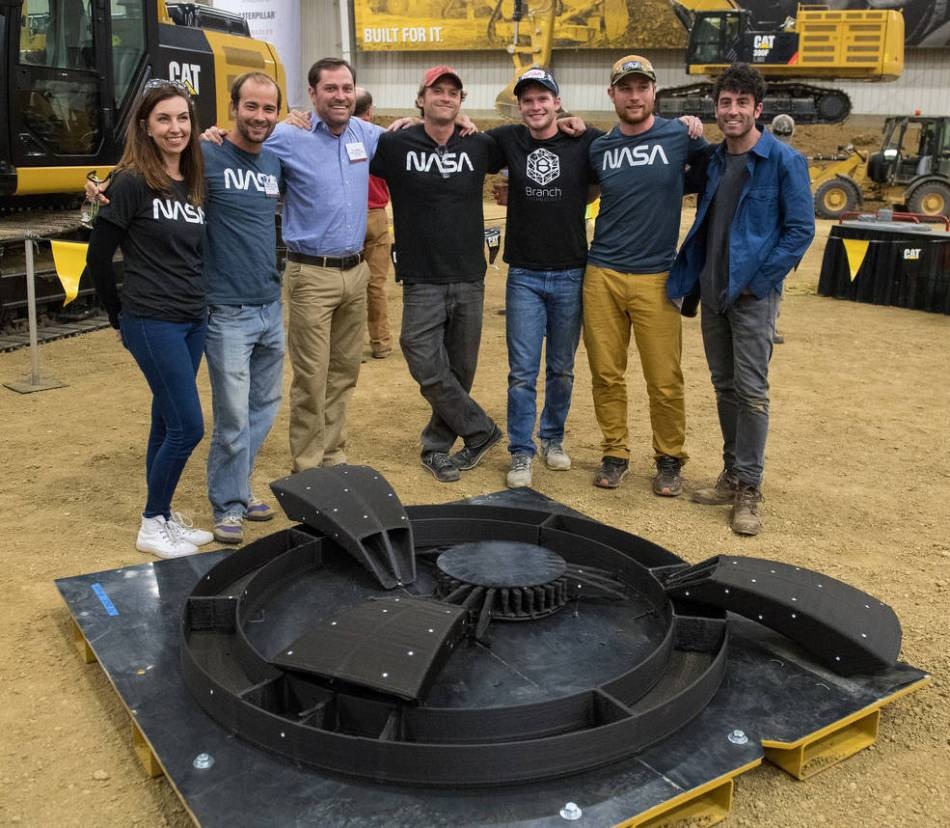Aug 29 2017
NASA is making advances and awarding prizes in its competition to develop a 3D-printed habitat for deep space exploration.
 The Foster + Partners | Branch Technology team from Chattanooga, Tennessee, with their 3D-printed dome structure after it was strength tested August 26, 2017, at Caterpillar Inc.'s Edwards Demonstration and Learning Center in Peoria, Illinois. The team won first place and $250,000 at Phase 2: Level 3 of NASA’s 3D-Printed Habitat Challenge. Credits: (NASA/Joel Kowsky)
The Foster + Partners | Branch Technology team from Chattanooga, Tennessee, with their 3D-printed dome structure after it was strength tested August 26, 2017, at Caterpillar Inc.'s Edwards Demonstration and Learning Center in Peoria, Illinois. The team won first place and $250,000 at Phase 2: Level 3 of NASA’s 3D-Printed Habitat Challenge. Credits: (NASA/Joel Kowsky)
The agency has awarded first place and a prize of $250,000 to Team Foster + Partners | Branch Technology of Chattanooga, Tennessee, for successfully finishing Phase 2: Level 3 of NASA’s 3D-Printed Habitat Challenge, a NASA’s Centennial Challenges prize competition. Pennsylvania State University of University Park got the second place, and a reward of $150,000.
Challenge activities were held between August 23 and 26 at Caterpillar’s Edwards Demonstration and Learning Center in Edwards, Illinois. At the awards ceremony held on August 26, teams were presented a check by Jim Reuter, deputy associate administrator for NASA’s Space Technology Mission Directorate.
The multi-phase, $2.5 million 3D-Printed Habitat Challenge is designed for improving construction technology necessary for developing sustainable housing solutions for Earth and beyond.
The advancement and innovation in additive construction that we’ve seen from these teams is inspiring. Meeting the technology goals of this challenge proves that competition can push boundaries, and their work puts us that much closer to preparing the way for deep space exploration.
Reuter.
Bradley University in Peoria, Illinois, is NASA’s 3D-Printed Habitat Challenge partner. Bradley University also collaborated with sponsors Caterpillar, Bechtel and Brick & Mortar Ventures to manage the competition.
Being a part of this competition has been an extraordinary opportunity for Bradley University. Our students, faculty, staff and the Peoria community had a chance to see history in the making. We are a part of transforming technology and reshaping the way we think about construction. This was inspiring, and I am certain it changed the lives of many who experienced it.
Bradley University President, Gary Roberts.
Teams had to create the main 3D printing technology essential for producing a structurally sound habitat, including the printer itself and construction materials. Competitors then had to print cylinders, beams, and domes that were assessed and compressed to failure to fix scores and prize awards. Public could come to the competition activities, and a number of industry leaders and local school groups were present at the event. Photos from the challenge events can be found on the NASA Headquarters’ Flickr site.
NASA’s Centennial Challenges Program is part of the agency’s Space Technology Mission Directorate, and is run by NASA’s Marshall Space Flight Center in Huntsville, Alabama.